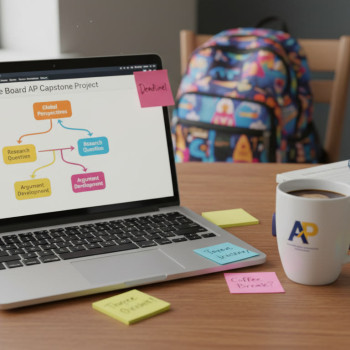What Is the AP Course & Exam Description (CED) — and Why Parents Should Care
If you’ve seen your child’s backpack packed with thick packets, heard the term “CED” mentioned at an open house, or watched them stare at a syllabus and wonder, “Is this really college-level?” — welcome. The AP Course & Exam Description (CED) is the College Board’s central document for every AP subject. It’s the roadmap teachers use, the standard colleges reference, and the most reliable source for what students are expected to learn and demonstrate on exam day.
Think of the CED as the course’s blueprint: it lists the big ideas and learning objectives, breaks the content into units or topics, describes the skills students must master, and shows how the exam assesses those skills. For parents this translates into clarity: what your teen is studying, why it matters, and how to best support them through the year.
How the CED Shapes the Classroom and the Exam
AP teachers design lessons, assessments, and pacing with the CED front and center. The exam writers then use the same framework to create questions. That alignment means your student’s classroom experience and the exam expectations are meant to match — a reassuring fact when you’re helping them prepare.

What’s Inside a Typical CED
While specific layout and sections vary by subject, most CEDs include the following key pieces. Knowing these will help you translate classroom talk into practical support.
- Course Framework: The “big ideas” and overarching themes of the course — the concepts teachers prioritize.
- Skills and Practices: The academic behaviors students must demonstrate (for example, analyzing data, crafting evidence-based arguments, or writing clearly under time constraints).
- Units or Topics: A suggested sequence of topics or units, often with recommended pacing and weight for each unit.
- Exam Overview and Question Types: How the exam is organized (multiple choice, free-response, performance tasks, digital submission, etc.) and the relative weighting of each section.
- Sample Questions and Scoring Guidelines: Model responses and rubrics that show what earns top marks.
- Course Resources and Appendices: Optional — may include sample curricula, assessment guides, or technology recommendations.
Why Each Section Matters for Your Student
When parents can connect a classroom unit to the exam’s weight and the skills it tests, study time becomes strategic instead of frantic. For instance, if a unit takes up 30% of the CED’s emphasis and is heavily tested, you’ll know to prioritize mastery in that area rather than spreading study time evenly across everything.
How To Read a CED — A Parent-Friendly Walkthrough
CEDs can feel dense at first glance. Here’s a simple way to approach one so you can have informed conversations with your child and their teacher.
Step 1 — Scan the Big Ideas and Course Overview
Start at the top. The big ideas are the high-level themes your child will return to throughout the year. Ask your student to point out which units connect to each big idea; that conversation alone reveals how they’re internalizing the course.
Step 2 — Locate Unit Weighting and Pacing Suggestions
Many CEDs suggest how much instructional time each unit should receive. Those weightings often reflect how much of the exam will assess a unit. If your teen is spending weeks on a low-weight topic and feeling stressed, it might be worth a gentle conversation with the teacher about pacing.
Step 3 — Review Exam Format and Sample Questions
The sample questions and scoring rubrics are gold. They show the exact style of thinking and the level of detail graders expect. Work through a sample free-response or multiple-choice problem with your student — you don’t need to know the subject deeply to ask, “How would you start? What evidence would you use?”
Step 4 — Note Suggested Prerequisites and Skills
Some CEDs list prerequisite knowledge or recommended high school courses. If your child’s missing a background skill (like algebraic manipulation or historical reading strategies), early intervention — tutoring, summer refreshers, or targeted practice — can prevent later anxiety.
Practical Ways Parents Can Use the CED to Help
Knowing the theory is one thing; putting it into practice is another. Below are concrete, realistic ways parents can support their teen using the CED as a guide.
1. Turn the CED into a Conversation Starter
Ask your child to show you a unit they find hard. Prompt them with questions like: “Which skills are you practicing here? How would you explain that skill to a friend?” This encourages metacognition — thinking about learning — which boosts study effectiveness.
2. Build a Targeted Study Calendar
Use the CED’s unit weighting to prioritize study sessions. Instead of equal time for every chapter, allocate more focused practice to heavily weighted units and exam-style questions. Keep the plan flexible: short daily sessions beat one marathon night.
3. Practice With the Rubrics
When teachers grade mock essays or practice problems, bring the scoring rubric to the table. Ask your child to self-evaluate using the rubric — this makes feedback specific and actionable.
4. Make Skills Transferable
Many AP skills — critical reading, constructing evidence-based arguments, interpreting graphs — are useful in everyday life. Pointing out these connections (for example, relating an AP Biology data table to sports analytics) keeps studying relevant and less abstract.
Sample Study Plan (Using the CED as a Roadmap)
The following table shows a simplified example of how a parent and student might translate CED unit weightings into weekly study focus during a 12-week review period before the exam.
| Unit | CED Weighting (Approx.) | Weekly Focus (Weeks 1–12) | Suggested Activities |
|---|---|---|---|
| Unit A (Core Concepts) | 30% | Weeks 1–4 | Daily topic questions, 1 practice FRQ per week, rubric review |
| Unit B (Applied Skills) | 25% | Weeks 3–6 | Data interpretation sets, timed MCQs, group review |
| Unit C (Synthesis and Analysis) | 20% | Weeks 5–8 | Essay practice, source integration, peer feedback |
| Unit D (Minor Topics) | 15% | Weeks 7–10 | Targeted drills, flashcards, short review quizzes |
| Exam Skills and Mock Tests | 10% | Weeks 9–12 | Full-length mock exams, time-management drills, reflection |
This is a flexible template. The CED tells you what matters most; you and your student decide how that fits into their life and extracurricular demands.
Common Questions Parents Ask About CEDs
Does the CED Change Every Year?
Major updates to a CED are relatively rare and are usually announced well in advance. Minor clarifications, sample question updates, or changes in suggested resources can happen more often. The important part for parents is that the CED is the authoritative guide for what the course and exam expect — teachers and schools align instruction to it.
Can My Child Take the Exam Without the Course?
Yes. Students can self-study and sit for the AP exam even if their school doesn’t offer the course. The CED becomes especially important in that situation because it lists the skills and content to be learned. Homeschooled students or those seeking extra support often use the CED as their syllabus.
How Can Parents Tell If a Practice Resource Matches the CED?
Look for practice materials that reference course frameworks, sample responses, and rubrics similar to those in the CED. Practice that mirrors the question types and thinking demanded in the CED will be far more effective than materials that only cover content factually without testing higher-order skills.
Helping Your Teen Use the CED — Specific Activities You Can Try
Small, consistent actions often yield the best results. Here are practical activities you can do with your child to turn CED content into confident performance.
- Weekly CED Check-In: Spend 20 minutes each week reviewing which unit your teen worked on and which CED skill it maps to. Celebrate progress and identify small gaps early.
- Practice Rubric Nights: Once a month, review a scored sample response together and discuss why it earned the grade it did.
- Official-Looking Mock Exams: Recreate exam conditions at home — timed sections, quiet environment, and limited interruptions. Debrief with empathy and focus on growth areas.
- Skill Swap Sessions: If your teen excels in one skill (e.g., data analysis), have them teach a short 10-minute lesson to you or a sibling. Teaching is a powerful way to deepen learning.
When to Consider Extra Help — Tutoring, Targeted Programs, and Personalized Support
Most students benefit from occasional help — not because they’re struggling, but because AP exams reward precision and efficiency. Consider extra support if you notice persistent stress, gaps in prerequisite skills, or inconsistent practice. Early, targeted help is usually more effective than last-minute cramming.
What Effective AP Support Looks Like
- One-on-one guidance that zeroes in on the student’s specific weaknesses.
- Study plans tailored to the CED’s unit weightings and the student’s school calendar.
- Experienced tutors who understand AP rubrics and how graders score responses.
- Regular, data-driven feedback so both student and parent can see progress.
For families seeking this kind of tailored help, Sparkl’s personalized tutoring model can fit naturally into a CED-focused plan. Sparkl offers 1-on-1 guidance, tailored study plans that map to unit weightings, expert tutors who use exam rubrics, and AI-driven insights to track progress — all designed to make study time efficient and less stressful.
Real-World Examples: Turning CED Insights Into Results
Here are two short examples showing how parents and students used the CED to change their approach and improve outcomes.
Example 1 — From Broad Review to Laser Focus
Case: A junior taking AP Biology was spending hours reviewing flashcards across every topic but still scoring poorly on practice tests. The CED showed that certain units (e.g., cellular energetics and genetics) made up a substantial portion of the exam’s focus.
Action: The family worked with the teacher and a tutor to create a study block that concentrated on those high-weight units for three weeks, using practice free-response questions aligned to the CED and timed sections to build endurance.
Result: The student gained clarity, felt less scattered, and significantly improved time management on the exam format, leading to better practice scores and more confidence.
Example 2 — Turning Anxiety Into Strategy
Case: A sophomore taking AP European History felt overwhelmed by long essay prompts and lost points for weak thesis statements.
Action: Using the CED’s rubric, the parent helped the student practice thesis-writing drills and evaluate sample essays. They scheduled brief weekly practice essays and used targeted feedback rather than general praise.
Result: By tailoring practice to the rubric and building a habit of short, focused essays, the student improved structure and clarity and reported less exam-day anxiety.
Digital Exams and CED Alignment
Some AP exams have shifted components to digital formats. The CED describes whether digital tools will play a role (for example, data analysis built into a testing app) and what technological skills students should have before test day. If your child’s exam is digital, check the CED and school communications for any tech requirements and practice using the same format when possible.
Final Thoughts: A Parent’s Role Is Supportive, Strategic, and Encouraging
Understanding the CED doesn’t mean you need to become an expert in the subject. It means you have a reliable guide for what matters most, which lets you ask smart questions, help your child prioritize, and know when to bring in targeted help — whether that’s a teacher conference, a study group, or a personalized tutor.
Remember these simple principles:
- Focus on skills and high-weight topics first.
- Use rubrics and sample responses to make feedback concrete.
- Prioritize short, consistent practice over last-minute marathons.
- Keep the conversation supportive — curiosity and steady progress beat perfectionism.
If your family wants structured, personalized support that maps directly to the CED, consider options that offer 1-on-1 guidance, tailored study plans, and measurable feedback. Programs like Sparkl that combine expert tutors with AI-driven insights can make study time more efficient and less stressful — a good fit for busy families who want targeted progress rather than generic coaching.

Quick Checklist for Parents Using the CED
- Find the CED for your child’s AP course and skim the big ideas and unit weightings.
- Ask your child’s teacher which units will receive the most classroom time and how practice is assessed.
- Schedule regular, short check-ins focused on skills rather than just content.
- Use sample questions and rubrics from the CED to guide practice and feedback.
- Consider targeted 1-on-1 help when gaps persist — prioritize tutors who map lessons to the CED.
Final Note
AP courses are an opportunity: they give students early exposure to college-level thinking and a chance to earn college credit. The CED is your family’s friend in that process — a clear, practical map that turns uncertainty into strategy. Support your teen with curiosity, small steady practices, and targeted help when needed, and you’ll be helping them build skills that last far beyond the exam.
Wishing you and your student a year of steady progress, clearer goals, and — yes — a little less stress.




















No Comments
Leave a comment Cancel